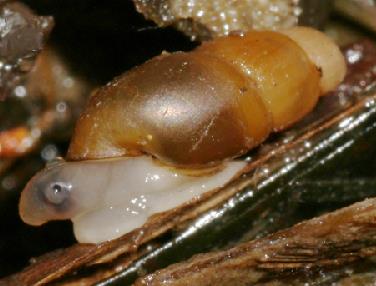Invasion History
First Non-native North American Tidal Record: 1961First Non-native West Coast Tidal Record: 1961
First Non-native East/Gulf Coast Tidal Record:
General Invasion History:
Cecina manchurica is native to the Northwest Pacific from the southern Kurile Islands, to the adjacent Russian coast of the Sea of Japan and Kyushu, Japan (Adams 1864; Golikov et al. 1976). It has been introduced to Washington State and southern British Columbia, most likely with Pacific Oysters from Japan (Morrison 1963; Carlton 1979; Carlton 1992; Forsyth 2003).
North American Invasion History:
Invasion History on the West Coast:
Cecina manchurica was first discovered in North America in 1961, under logs and drift algae at the high-tide line in Chuckanut Bay, Washington (WA) (Morrison 1963). It was subsequently found in Birch Bay, WA (Duggan 1963, cited by Carlton 1979); Willapa Bay, WA (in 1963 and 1977; Hanna 1966; Carlton 1979); and Boundary Bay, British Columbia (Carlton 1992; Klinkenberg 2013). Habitats in which it has been found include piles of old oyster shells, salt marsh edges, logs, and drift piles of seaweed and seagrasses (Adams 1864; Morrison 1963; Golikov et al. 1976; Carlton 1979). A likely vector is transplantation of Pacific Oysters (Crassostrea gigas); although not the oysters themselves, but the boxes, baskets, and racks used in shipping and rearing oysters. These are often stored on beaches, near oyster beds (Carlton 1979).
Description
Cecina manchurica is a small, semi-terrestrial marine snail, which inhabits the upper intertidal zone of marshy and rocky shores. The shell is dextrally coiled, thin-walled and translucent. Adult shells have 3-4 whorls with deep sutures and a highly eroded spire, resulting in a lumpy, elongated-ovoid shape. The shell is marked by fine growth lines with a dark brown edge around the aperture. Shells grow up to 7.2 mm in length and about 3 mm in diameter. The border of the mouth is dark brown. Description from: Adams 1864; Golikov et al. 1976; Prozorova 2003.
Taxonomy
Taxonomic Tree
| Kingdom: | Animalia | |
| Phylum: | Mollusca | |
| Class: | Gastropoda | |
| Subclass: | Prosobranchia | |
| Order: | Mesogastropoda | |
| Family: | Pomatiopsidae | |
| Genus: | Cecina | |
| Species: | manchurica |
Synonyms
Potentially Misidentified Species
Native to the Northwest Pacific coast of Russia
Cecina tatarica
Native to the Northwest Pacific coast of Russia
Ecology
General:
Cecina manchurica, the Oriental Cecina, is a small, semi-terrestrial marine snail found in the upper intertidal zone of marshy and rocky shores under logs, seaweed, in piles of oyster shells, etc. (Adams 1864; Golikov et al. 1976). We have no information on the mode of reproduction of C. manchurica. It is found on poly-euhaline shores (Prozorova 2003), but in its upper-intertidal habitat it is probably frequently exposed to low salinity during rainfall, as well as a wide range of temperatures. Likely foods include bacteria, blue-green algae, diatoms, macroalgae, fungi, and the epithelial cells of vascular plants, similar to the diet of Myosotella myosotis (Berman and Carlton 1991).
Food:
Algae
Trophic Status:
Herbivore
HerbHabitats
| General Habitat | Rocky | None |
| General Habitat | Coarse Woody Debris | None |
| General Habitat | Marinas & Docks | None |
| Salinity Range | Polyhaline | 18-30 PSU |
| Salinity Range | Euhaline | 30-40 PSU |
| Tidal Range | High Intertidal | None |
| Tidal Range | Supratidal | None |
| Vertical Habitat | Epibenthic | None |
Tolerances and Life History Parameters
| Maximum Length (mm) | 7.2 | Golikov et al. 1976 |
| Broad Temperature Range | None | Cold temperate-Warm temperate |
| Broad Salinity Range | None | Polyhaline-Euhaline |
General Impacts
No impacts have been reported for Cecina manchurica in its introduced range.Regional Distribution Map
Non-native
Native
Cryptogenic
Failed
Occurrence Map
References
Abbott, R. Tucker (1974) American Seashells, Van Nostrand Reinhold, New York. Pp. <missing location>Academy of Natural Sciences of Philadelphia 2002-2024a Malacology Collection Search. <missing URL>
Adams, Arthur (1864) On some new genera and species of Mollusca from China and Japan, Annals and Magazine of Natural History 13(3): 299-309
Berman, Jody; Carlton, James T. (1991) Marine invasion processes: Interactions between native and introduced marsh snails, Journal of Experimental Marine Biology and Ecology 150(2): 267-281
Carlton, James T. (1979) History, biogeography, and ecology of the introduced marine and estuarine invertebrates of the Pacific Coast of North America., Ph.D. dissertation, University of California, Davis. Pp. 1-904
Carlton, James T. (1992) Introduced marine and estuarine mollusks of North America: An end-of-the-20th-century perspective., Journal of Shellfish Research 11(2): 489-505
Collado-Vides, L. (2002) Morphological plasticity of Caulerpa prolifera (Caulerpales, Chlorophyta) in relation to growth form in a coral reef lagoon, Botanica Marina 45: 123-129
Forsyth, Robert G. (2003) Northern range extension for Assiminea translucens (Carpenter, 1864), Festivus 35(2): 17-18
Golikov, A. N. and 7 other editors. (1976) <missing title>, Nauk, Leningrad. Pp. <missing location>
Hanna, G. Dallas (1966) Introduced mollusks of Western North America, Occasional Papers of the California Academy of Sciences 48: <missing location>
Klinkenberg, Brian 2010-2013 E-Fauna BC: Electronic Atlas of the Fauna of British Columbia. <missing URL>
Morrison, J. P. E. (1963) Cecina from the state of Washington, Nautilus 76(4): 150-151
Prozorova, L. A. (2003) Morphological features of supralittoral mollusks of the genus Cecina(Gastropoda: Pomatiopsidae) from Peter the Great Bay, Sea of Japan, Russian Journal of Marine Biology 29(1): 49-52
